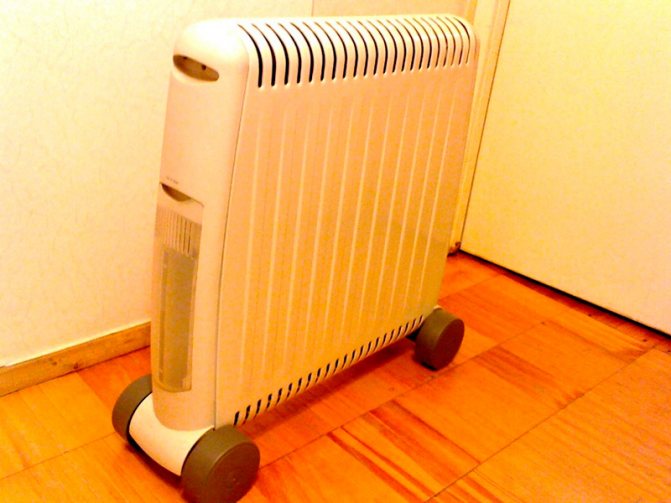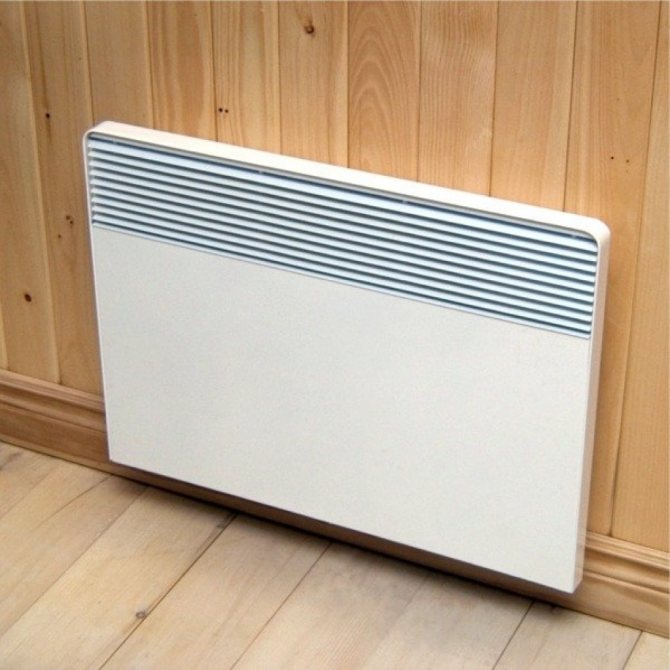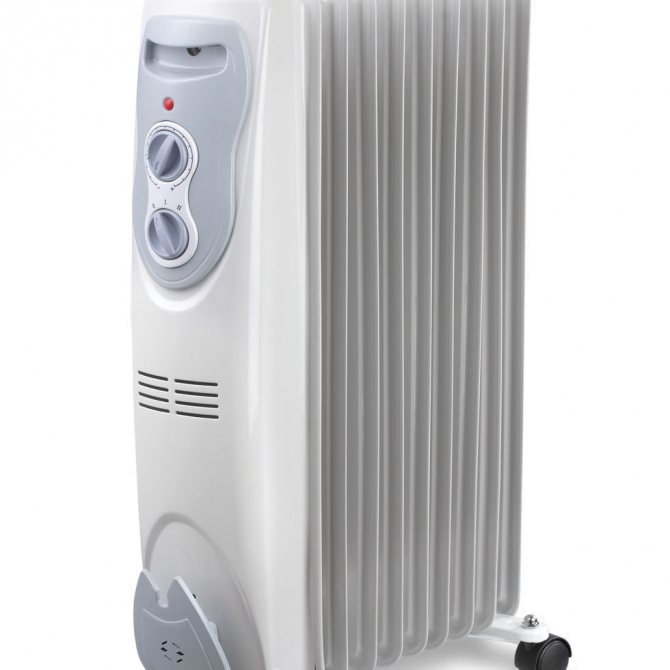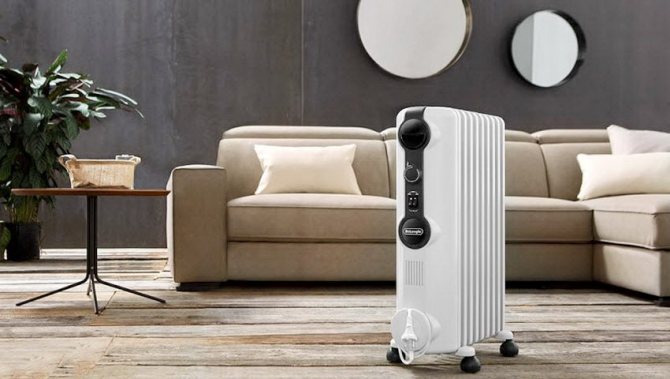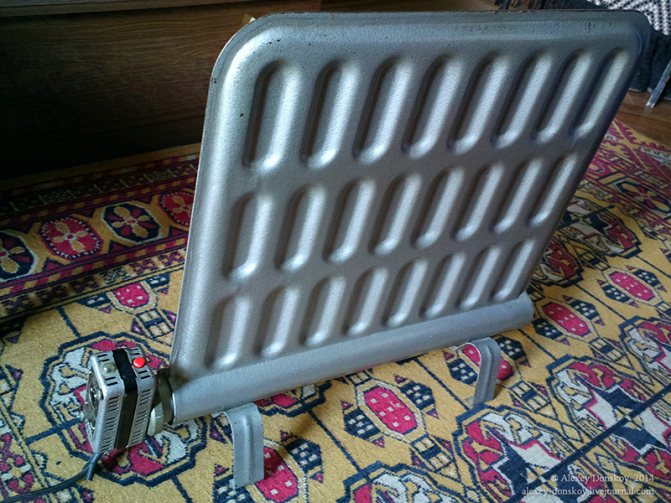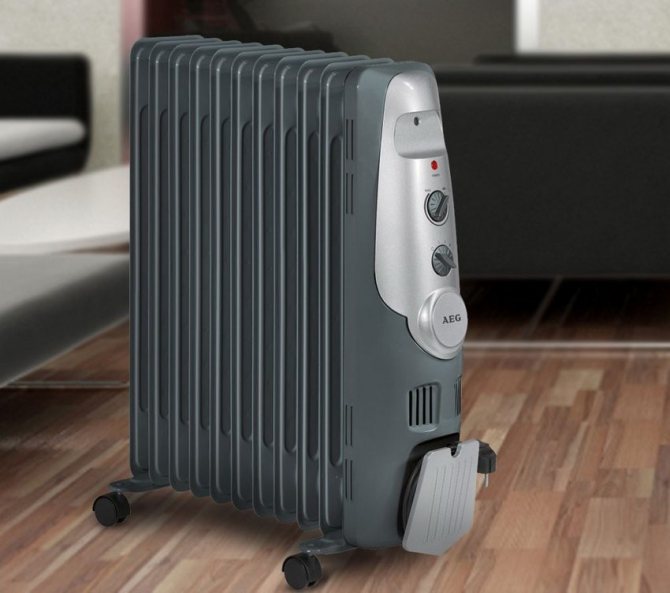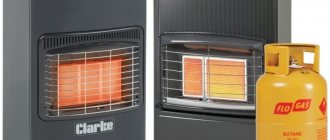Many owners of private houses in the cold season heat their home with oil heaters. Residents of apartments also use these means of heating, since central heating is not always sufficient to heat rooms in winter. The popularity of oil appliances is due to their many advantages. To choose the best heater for heating your home, it is recommended to study the specifications, selection criteria and rating of the best oil-fired electric heaters.
Design features and principle of operation
Oil heaters have a simple design, which consists of the following elements:
- body;
- thermostat;
- panel;
- a pen;
- cap;
- power cable;
- coil.
Heating elements are installed inside the radiator and 85% is filled with oil, which, when heated, expands and fills the device completely. Oil is heated from heating elements, which, after turning on the electric heater in the network, begin to warm up. The heated oil liquid heats up the metal case, from which heat is emitted and the room is heated.
Types of oil coolers
Home appliance stores offer a large selection of heaters, from which you can choose:
- Floor structures are the most common appliances for space heating, which are equipped with wheels and are easy to move around the apartment. Floor-standing appliances most often consist of several ribs, due to which the heating efficiency is increased.
- Wall heaters - heating equipment in appearance resembles electric convectors or panel batteries. They are thinner than floor structures and have no ribbing.
- Heaters with a humidifier - the appliance is equipped with a water tank. When the radiators are heated, the water heats up and begins to evaporate, thereby humidifying the air in the room.
- An oil cooler with a fan is a design that combines a conventional air heater, a heat gun and a convector. A built-in low-noise fan sends warm air outside, which means that the room heats up much faster.
Understanding the details
If we compare the cost of a conventional fan heater and an oil heater, the result will clearly not be in favor of the latter. People who are poorly versed in the peculiarities of the operation of different types of heating devices may be tempted to save money, which they will bitterly regret in the future.
Strengths of an oil cooler
Such heating devices are simply ideal for the role of an additional heat generator in the house.
Ease of use provides the following set of benefits:
- reliability, such devices are used not only for home heating, for example, oil coolers for hydraulic systems are used when it is necessary to maintain a constant temperature of the hydraulic oil. This is a responsible task, they cope with it perfectly, so that at home their effectiveness is quite high;
- profitability - due to the presence of a thermostat, the heater will not work all the time. After the oil temperature in the device reaches the set value, the heating element will operate in a cyclic mode, periodically turning on when the oil cools below the specified threshold;
- installation as such is not necessary, you just need to install the radiator in the right place. Manufacturers often equip heavy models with wheels and a handle, so that even a child can carry it from room to room with his own hands;

Wheels make it easier to move
- the surface of the device does not get hot, the maximum temperature is usually around 80 ᵒС (but this is the maximum), usually it is in the range of 60-70 С. So the radiator can be safely left even in the nursery;
Oil heater is absolutely safe
- the fan, if provided by the manufacturer, rotates at low speeds and does not drive dust around the room, as a conventional fan heater does;
Several models with fan
- manufacturers produce models of oil coolers in a wide range of prices, so you can pick up both a budget option and a more expensive model;
- quite often, when an oil cooler is chosen - whether oxygen burns is almost the main criterion... In this regard, you can not worry, heating elements do not come into contact with air, so the air is not burnt out either;
- due to the developed ribbing, oil heaters have a large surface area... This increases heat dissipation.
Note! When using fan heaters, the already dry air in winter becomes simply unbearable. So the oil heater is a winner in this indicator.
There are not so many disadvantages, it can be noted only that:
- slow speed of warming up the room;
- cost, after all, the price of such devices reaches several thousand rubles, so the purchase does not always look justified.
Advantages and disadvantages
The popularity of oil heaters is due to their many advantages. These include:
- fast warming up of the room;
- mobility;
- small size;
- attractive design;
- long service life with proper operation;
- does not need special maintenance;
- simple connection;
- after turning off, the unit heats up for a long time, since the oil cools down for a long time;
- high rate of fire safety;
- environmental friendliness;
- works without noise;
- simple control system;
- budget price.
Like any other device, oil heaters have their disadvantages:
- high temperature of the case, about which you can burn yourself;
- high power consumption.
Criterias of choice
When choosing an oil-powered electric heater for your home, it is recommended to pay attention to its power, dimensions, number of sections and additional functions.
The power of the devices can be from 0.5 to 3 kW. For your home, you need to choose a unit at the rate of 1 kW per 10 square meters of room. In this case, the room should have one window, and the ceiling height should be from three meters. If there are more windows in the room, then 0.2 kW is added for each window.
It is very important to pay attention to the number of sections, which should depend on the area of the room. At the same time, units with fewer sections heat up much faster. Stores offer heaters that can have anywhere from five to twelve sections.
Weight plays an important role in the quality and performance of the device. If the unit is bulky and at the same time lightweight, it is better to refuse the model. A large oil heater cannot be light. Low weight is achieved by lowering the oil level and using thin metal.
The built-in automatic thermostat will help to regulate the air temperature. If you set the required room temperature on it, the thermostat will maintain it in automatic mode. It is recommended to pay attention to the presence of this function, insofar as not all devices are equipped with automatic thermostats.
For cold rooms, it is recommended to choose heaters with fan heaters. The noise level during the operation of such a unit should be as low as possible, which must be checked upon purchase.
Almost all oil heaters are equipped with casters that make them easy to move. When choosing a heavy device, you need to pay attention to the fact that the rollers are rubberized.When moving on the floor, they will not scratch the surface.
It is not uncommon to see units with a clothes dryer. This is a very convenient additional element that can be used in the off-season, when the batteries have already been turned off, and the heat outside has not yet come.
If the heater will be chosen for a children's room, then you should choose a model with a casing or buy it separately. Otherwise, the child may burn itself on the hot sections.
When choosing a model of an oil heater, it is necessary to take into account the fact that the more additional functions the device has, the more expensive it is.
Distinctive features of various models
This type of electric heater can differ according to the following criteria:
- Power
- Design features
- Additional functions
Power
Today, there are products with a capacity of 1 to 3 kW. As a rule, the lineup is represented by the following values: 0.5; one; 1.2; 1.5; 2; 2.5; 3 kW. The latter option is extremely rare in the range. For home heating, it is enough to choose a 2 kW oil heater, although below we will tell you in more detail which device is better to buy.
Design
Like any other electrical product, an oil cooler can have various design features that affect cost and usability.
The first difference is the presence of handles with which you can move the unit from place to place. As a rule, such devices are available in all modern models.
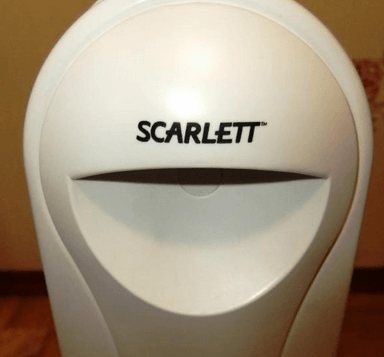

The next difference is the presence of a protective casing. This element will protect the surrounding objects and people from the high temperature of the case. A very useful device, the only drawback of which is problematic wet cleaning (the grates are difficult to wash out).


Well, the last, perhaps the most important design difference is the width and number of sections. The narrower the sections, the faster they warm up to working condition and at the same time consume less electricity. The reverse side of the coin is the time until the room completely warms up, which will also increase in this case. If you choose an oil heater with wide sections, the room will become warm faster, but at the same time, the energy consumption will be higher.
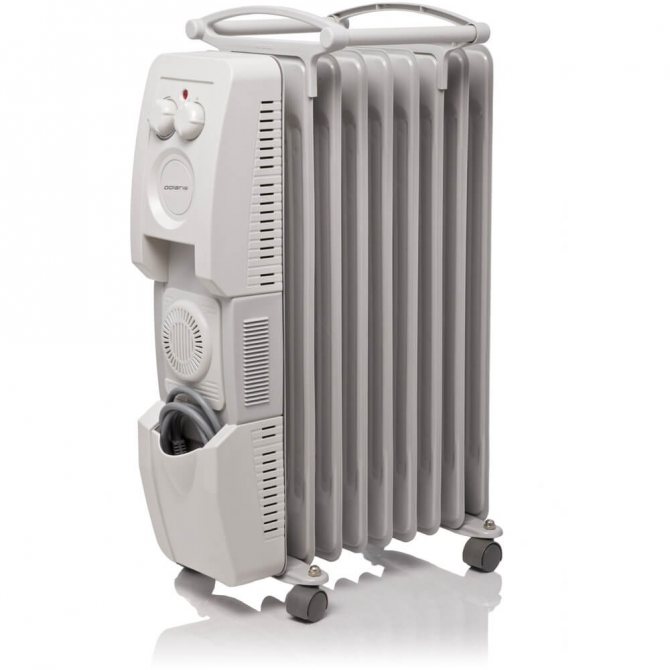

In addition, the wider the dimensions of the sections, the faster they will cool down. Conversely, a small radiator will keep the heat off for longer.
Video review of the characteristics of the oil heater
Additional functions
To help you understand how to choose the right oil heater, below we will provide an overview of the most necessary functions that may be present.
So, when choosing, pay attention to the following device capabilities:
- Mode switch, with which you can adjust the power of the product, and, accordingly, the heating efficiency in the house or apartment.

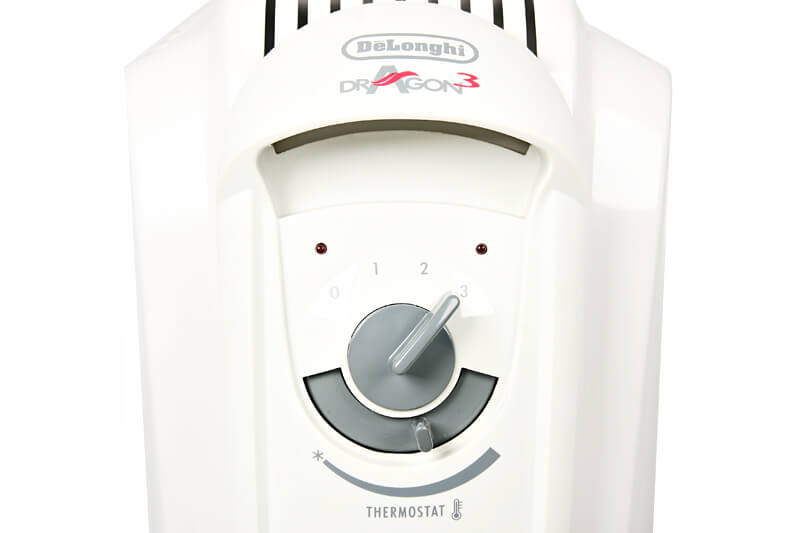
- A timer that allows you to set a specific power on / off time. A very convenient thing for those who like to come from work to an already heated house. On the timer, you just need to select the start time a couple of hours before arrival.


- Temperature regulator. We draw your attention to the fact that in this case the temperature is not regulated in the room, but inside the case (on the heating element).

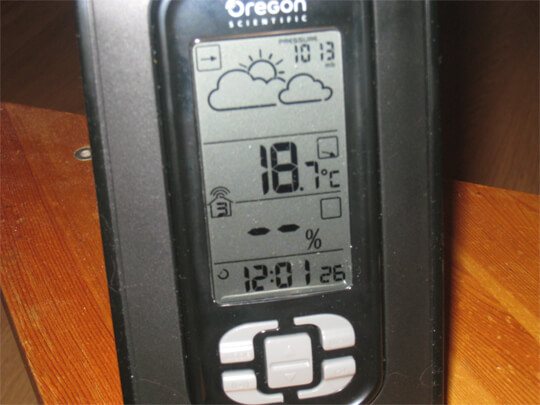
- A humidifier that solves one of the existing problems of oil heaters - air dehumidification. A special container with water is installed on the radiator and as a result of heating the water evaporates, thereby slightly increasing the humidity in the room.

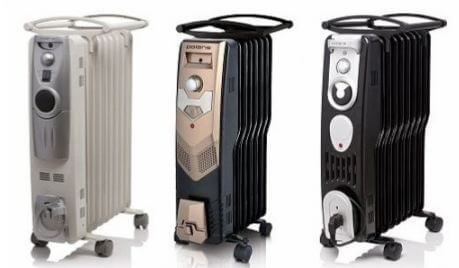
- A fan heater that allows you to warm up the room faster. The device is installed near the radiator, and during operation it creates a stream of warm air.

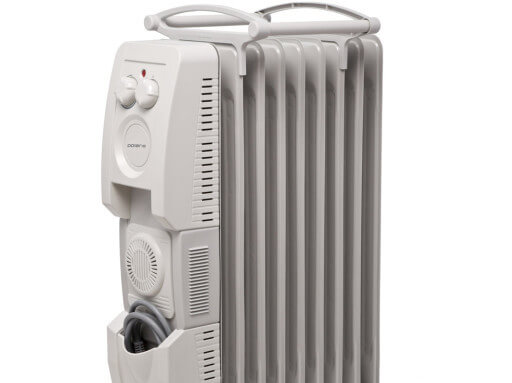
- Overheat protection.A very important function of the oil heating radiator, which will prevent a fire from starting when the heating element heats up to a temperature higher than the nominal one.
- Dryer for clothes (no less important addition to the set), because drying clothes on heated sections is prohibited by safety rules.

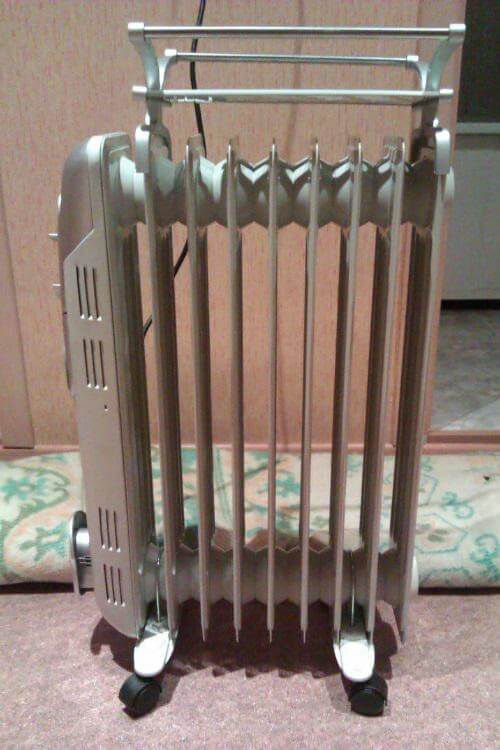
- Fireplace effect. Another cool feature that many manufacturers use. The chimney effect consists of special thermal slots located on the sides of the radiator. Thanks to the slots, the air in the room heats up 2 times faster, because continuous air convection occurs. Many praise models with a fireplace effect.
Rating of the best oil heaters
High power devices
Unit UOR -123
The eleven-section floor-standing oil cooler has three power levels and is recommended for use in a room with an area of 25 square meters. The required temperature of the device is adjusted using a special knob. An adjustable thermostat is built into the control, thanks to which, when the room reaches the desired temperature, the heater turns off.
Advantages:
- light indicator of inclusion;
- built-in overheating protection.
Timberk TOR 31.2912 QT
The device for space heating has a high power of 2900 W and is equipped with 12 sections. Despite the large number of sections, the unit is lightweight. It has three power levels, oil leakage protection and a built-in fan that helps to quickly heat the air in the room.
Advantages:
- overheating shutdown;
- frost protection.
The disadvantages of the device include the loud operation of the fan.
EWT OR 125 TLG
A large oil electric heater has a high power of 2500 W, 11 sections and a fan heater, due to which it warms up the air quickly enough. After turning it off, it stays warm for a long time and keeps the room warm. The operation of the device is regulated mechanically.
Advantages:
- overheating shutdown;
- frost protection;
- high power;
- built-in fan.
Medium power oil units
RESANTA OM -7 NV
The seven-section radiator has an unusual, modern design, so it is able not only to heat a room, but also to complement any interior. Small dimensions, a power cord winding mount and wheels will allow you to move the device from place to place without much difficulty. The power of 1900 W and the operation of the built-in fan will quickly heat up the room.
Advantages:
- automatic temperature maintenance mode;
- high performance;
- interesting design.
There were no significant drawbacks to this model..
Timberk TOR 21/1005 SLX
The oil heater, consisting of five sections, has a capacity of 1,000 W and a special technology that protects the device from oil leakage. The model has three power levels, which allows you to adjust the comfortable temperature in the room. Storing the device simplifies the cord reel compartment.
Advantages:
- heats up the room quickly;
- fireplace effect;
- electronic control.
Lack of the model - sections that can get burned are very hot.
RESANTA OM-09N
A powerful and at the same time simple oil heater has a power of 9 thousand watts and 9 sections. It heats large and medium sized rooms quickly and well. The device is equipped with wheels, due to which it can be easily moved from place to place. In order for the unit to maintain the desired temperature in the room, it is enough to adjust its operation by simply turning the knob.
Advantages:
- high power;
- equipped with a handle and cord compartment;
- indicator light.
The downside of the model is a rather large weight of almost ten kilograms.
Timberk TOR 31.1907 QT
The seven-section oil heater with a fan and a power of 1900 W is moved by means of castors.The required temperature on the device is regulated mechanically, and when the desired climate is reached, the unit is turned off for a certain time. The model is protected from oil leakage by a special technology.
Advantages:
- frost protection;
- overheat protection;
- built-in fan, thanks to which the air heats up quickly.
Disadvantages:
- the device is unstable;
- noisy fan operation.
Timberk TOR 51.2009 BTM
The unusual oil heater consists of nine undulating sections. The ribs made in the form of waves have a large area, due to which the unit generates more heat. In addition, a heater with wavy sections looks very original. A 9,000-watt appliance burns very little electricity and heats large rooms quickly.
Advantages:
- high-quality assembly;
- overheat protection;
- frost protection;
- unusual structure of sections.
How safe are oil-fired radiators?
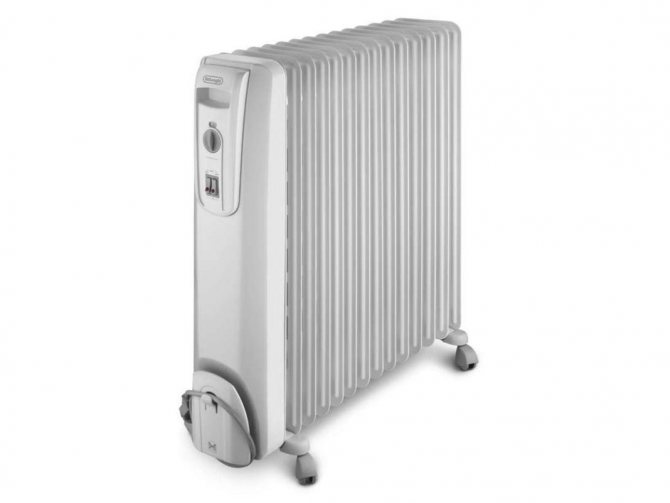

Safe radiator
When choosing an oil electric heater, you must immediately take into account the fire safety rules. The housings of such devices are explosion-proof and fireproof, fire can only occur due to a faulty electrical wiring or violations of operating rules.
Faulty wiring
Heaters are equipped with overheating sensors that turn off the device when the temperature rises above the safe limit. Therefore, a fire from an overheated case is simply impossible, and problems often arise due to a malfunction of the wiring in the house or its inadequacy to the required characteristics. Experts recommend using dedicated lines providing a voltage of 1-2 kW when installing oil radiators. If you connect another powerful electrical appliance to this line, for example, a washing machine, the fire can hardly be avoided. But even in the event of a short circuit in the network, the device instantly turns off.
Incorrect operation
Most of the fires involving heaters are not due to a malfunction of the device, but due to a violation of the rules of operation. Do not install radiators in rooms with high levels of humidity or open sources of water, for example, for swimming pools and toilets. It is forbidden to dry laundry on the surface of the device without using a special removable dryer. In addition, heaters must not touch walls, furniture or curtains during installation.
If for any reason the thermostat fails, the surface of the case may heat up to 150 degrees. If there is no function of light or sound signaling of malfunctions, it will not be possible to immediately notice the breakdown. Therefore, it is worthwhile to immediately install the radiator out of the reach of children or pets, observe the minimum distance from furniture and textiles (indicated by the manufacturer in the passport to the device).
